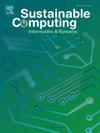Secured energy optimization of wireless sensor nodes on edge computing platform using hybrid data aggregation scheme and Q-based reinforcement learning technique
IF 3.8
3区 计算机科学
Q1 COMPUTER SCIENCE, HARDWARE & ARCHITECTURE
引用次数: 0
Abstract
Wireless Sensor Network (WSN) security and energy consumption is a potential issue. WSN plays an important role in networking technologies to handle edge devices on a heterogeneous edge computing platform. For faster processing of sensor nodes on an Industrial Internet of Everything (IIOE), an efficient computing technique for an emerging networking technology is being explored. As a result, the proposed study provides a chaotic mud ring-based elliptic curve cryptographic (CMR_ECC)-based encryption solution for WSN security. In the proposed WSN environment, various sensor nodes are deployed to collect data. To enhance the network lifetime, the nodes are combined into clusters, and the selection of cluster heads is performed with a fuzzy logic-based osprey algorithm (FL_OA). After the encryption process, the most optimal key selection process is performed with a hybrid chaotic mud ring algorithm, and the encrypted data are optimally routed to varied edge servers with a hybrid Chebyshev Gannet Optimization (CGO) approach. The data aggregation is performed with a Q-reinforcement learning approach. The proposed work is implemented with MATLAB. For 500, 750, and 1000 WSN sensor nodes, the proposed technique resulted in energy consumption values of 0.28780005 mJ, 0.31141 mJ, and 0.339419 mJ, respectively.
基于混合数据聚合方案和基于q的强化学习技术的边缘计算平台无线传感器节点安全能量优化
无线传感器网络(WSN)的安全性和能耗是一个潜在的问题。无线传感器网络在异构边缘计算平台上处理边缘设备的网络技术中起着重要的作用。为了在工业万物互联(IIOE)中更快地处理传感器节点,人们正在探索一种用于新兴网络技术的高效计算技术。因此,本研究提供了一种基于混沌泥环的椭圆曲线加密(CMR_ECC)的WSN安全加密方案。在提出的WSN环境中,部署了各种传感器节点来收集数据。为了提高网络的生存时间,将节点组合成簇,并使用基于模糊逻辑的鱼鹰算法(FL_OA)进行簇头的选择。加密过程结束后,采用混合混沌泥环算法进行最优密钥选择过程,并采用混合切比雪夫鹅网优化(CGO)方法将加密数据最优地路由到不同的边缘服务器。数据聚合是用q -强化学习方法进行的。所提出的工作用MATLAB实现。对于500、750和1000个WSN传感器节点,该技术的能耗值分别为0.28780005 mJ、0.31141 mJ和0.339419 mJ。
本文章由计算机程序翻译,如有差异,请以英文原文为准。
求助全文
约1分钟内获得全文
求助全文
来源期刊

Sustainable Computing-Informatics & Systems
COMPUTER SCIENCE, HARDWARE & ARCHITECTUREC-COMPUTER SCIENCE, INFORMATION SYSTEMS
CiteScore
10.70
自引率
4.40%
发文量
142
期刊介绍:
Sustainable computing is a rapidly expanding research area spanning the fields of computer science and engineering, electrical engineering as well as other engineering disciplines. The aim of Sustainable Computing: Informatics and Systems (SUSCOM) is to publish the myriad research findings related to energy-aware and thermal-aware management of computing resource. Equally important is a spectrum of related research issues such as applications of computing that can have ecological and societal impacts. SUSCOM publishes original and timely research papers and survey articles in current areas of power, energy, temperature, and environment related research areas of current importance to readers. SUSCOM has an editorial board comprising prominent researchers from around the world and selects competitively evaluated peer-reviewed papers.
 求助内容:
求助内容: 应助结果提醒方式:
应助结果提醒方式:


